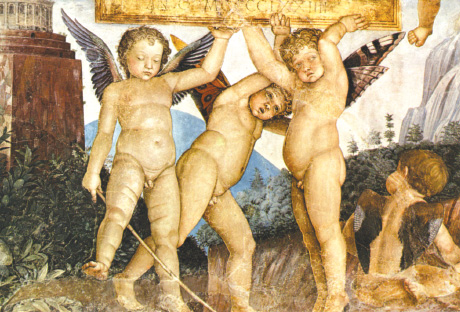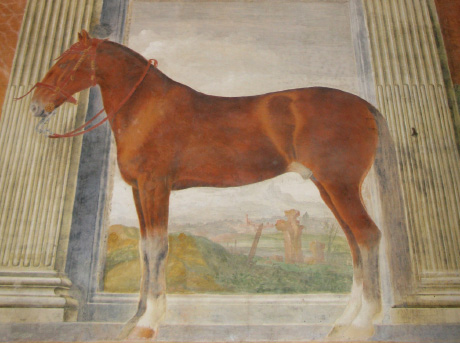![]()
PROTECTED to the north by a bend of a tributary of the Po, the Mincio, where it forms two lakes, Mantua had the distinction of being mentioned in the Aeneid and has long been one of the major towns of the Po Valley. But it is to the Gonzaga that it owes its outstanding monuments. Luigi Gonzaga secured the signoria in 1328. His descendants were successively marquises from 1433 and dukes from 1530. The direct line died out in 1627. In the resulting war the city was sacked and the ducal picture collection sold to King Charles I of England. Neither under the cadet branch of the family which succeeded, nor under subsequent imperial rule, did Mantua fully recover.
The prodigious ducal palace is at the north-eastern corner of the town, protecting the Ponte San Giorgio, Mantegna’s view of which in his Death of the Virgin in the Prado is still recognizable. The entrance to the palace is on the unexpectedly large Piazza Sordello. The medieval building was altered as fashion dictated until the eighteenth century. Its plan is complex. And the public tour is exhaustive. The relatively recently discovered fresco by Pisanello marks the emergence of the Gonzaga as sophisticated patrons, and works by Rubens and Feti testify to the enduring artistic leanings of the family. At the heart of the palace is the late fourteenth-century Castello di San Giorgio. The courtyard was designed by Mantegna and executed by the Florentine architect Luca Fancelli, Perugino’s father-in-law. Successive remodellings have mercifully spared what must always have been the most thrilling room in the castle, the Camera degli Sposi. Frescoed by Mantegna between 1472 and 1474 for Marchese Ludovico Gonzaga, this is one of the high points of Renaissance art. Inspired by his profound study of antiquity, the painter records his patron and his relations and hangers-on with a heroic objectivity. Long known as the ‘camera picta’, the painted room, the Camera dei Sposi was unprecedented in the implied unity of its pictorial surfaces and the intelligence – and beauty – of Mantegna’s visual conceits.

Palazzo Ducale: Andrea Mantegna, Camera degli Sposi, fresco (detail).
After such a masterpiece, the Duomo on the other side of the Piazza Sordello may come as an anticlimax. Yet, despite the late façade, this too is a pioneering building, designed by Raphael’s artistic co-heir, Giulio Romano, court painter to Francesco II Gonzaga, who succeeded at Mantua in 1519.
At the southern end of the piazza, the Voltone di San Pietro leads to the Piazza delle Erbe. On the opposite side of this, to the right, is the most celebrated of Mantua’s churches, Sant’Andrea. This was planned by the high priest of Quattrocento classicism, Leon Battista Alberti, in 1470 and begun two years later by Fancelli; the massive late baroque cupola was designed by Filippo Juvarra. The interior is monumental yet restrained, and in it, most appropriately, is the tomb of Mantegna. Work on the church overlapped with that on San Sebastiano 800 metres south-west on the Largo XXIV Maggio. This was designed by Alberti in 1460. Restoration has not affected the integrity of the elegant interior, perhaps the first of the Renaissance on a Greek cross plan.
Continuing in the same direction for 300 metres, one is confronted on the left by the uncompromising rusticated façade of the Palazzo Te, the extraordinary villa created for Francesco II Gonzaga between 1525 and 1535 by Giulio Romano. A painter by training rather than an architect, Giulio was wonderfully inventive in his deployment of architectural forms. Yet, however original the building must have seemed to contemporaries, it is in the frescoed decoration that Giulio’s own restless personality was more freely expressed. He knew how to divert his patron – and succeeded triumphantly. The visitor can still see why. The Sala dei Cavalli, with heroic murals of horses, is followed by the most sophisticated of all Giulio’s mythological compositions in the Sala di Psiche. Giulio’s imagination was fertile. Almost simultaneously he could design elaborate silver vessels – all alas lost – and the overwhelming drama of the Fall of the Giants in the Sala dei Giganti. Giulio was supported by an équipe of painters who worked from his own clearly defined drawings. He was fortunate in the skill of his associates, including the young Francesco Primaticcio, whose work at Fontainebleau was to be a natural sequel to the project.
The strategic importance and long economic prosperity of the Po Valley mean that the area has a rich architectural inheritance. Late medieval brick fortifications abound, and lesser dynasties ensured that their towns echoed those of more powerful counterparts. Cadet branches of the Gonzaga were no exception. At Sabbionetta, thirty-three kilometres south-west, Vespasiano Gonzaga created his own capital on a grid plan. Both the Palazzo Ducale and the Palazzo del Giardino were begun in 1568, to be followed by the octagonal church of the Incoronata and Vincenzo Scamozzi’s sophisticated Teatro all’Antica. Another branch of the family held Castiglione delle Stivere, thirty-eight kilometres north-west of Mantua. Here too there is a former ducal palace; equally imposing is the Collegio delle Nobili Vergini, founded for daughters of families who did not wish to pay dowries by the brother of the then marquis, the future San Luigi dei Gonzaga. Sabbionetta and, less immodestly, Castiglione show how the Gonzaga and their buildings at Mantua influenced their relations.

Palazzo Te: Sala dei Cavalli, designed by Giulio Romano, fresco (detail).